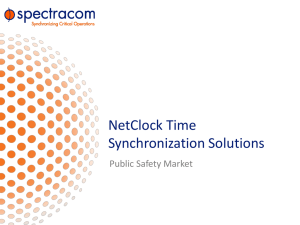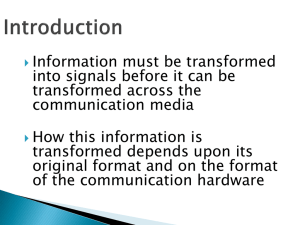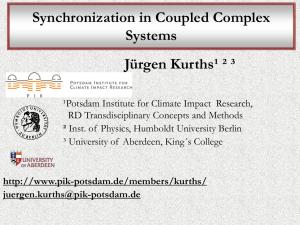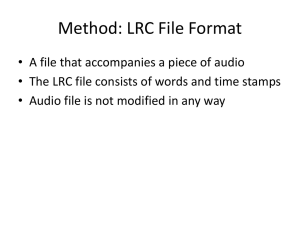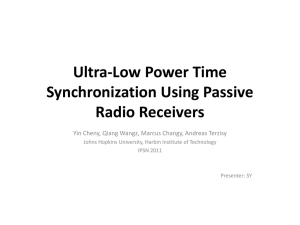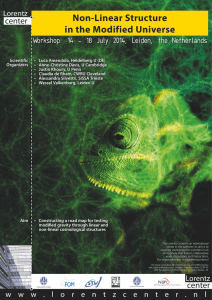Synchronicity
advertisement
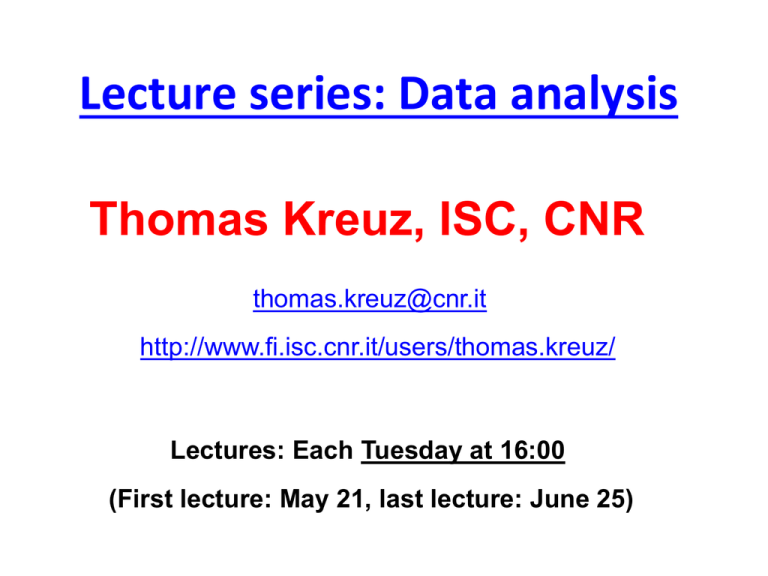
Lecture series: Data analysis Thomas Kreuz, ISC, CNR thomas.kreuz@cnr.it http://www.fi.isc.cnr.it/users/thomas.kreuz/ Lectures: Each Tuesday at 16:00 (First lecture: May 21, last lecture: June 25) Schedule • Lecture 1: Example (Epilepsy & spike train synchrony), Data acquisition, Dynamical systems • Lecture 2: Linear measures, Introduction to non-linear dynamics • Lecture 3: Non-linear measures • Lecture 4: Measures of continuous synchronization • Lecture 5: Measures of discrete synchronization (spike trains) • Lecture 6: Measure comparison & Application to epileptic seizure prediction First lecture • Example: Epileptic seizure prediction • Data acquisition • Introduction to dynamical systems Second lecture Non-linear model systems Linear measures Introduction to non-linear dynamics Non-linear measures - Introduction to phase space reconstruction - Lyapunov exponent Third lecture Non-linear measures - Dimension [ Excursion: Fractals ] - Entropies - Relationships among non-linear measures Characterizition of a dynamic in phase space Stability (sensitivity to initial conditions) Density (Information / Entropy) Predictability Determinism / Stochasticity Linearity / Non-linearity Self-similarity (Dimension) Dimension (classical) Number of degrees of freedom necessary to characterize a geometric object Euclidean geometry: Integer dimensions Object Point Line Square (Area) Cube (Volume) N-cube Dimension 0 1 2 3 n Time series analysis: Number of equations necessary to model a physical system Hausdorff-dimension Box-counting Box-counting Richardson: Counter-intuitive notion that a coastline's measured length changes with the length of the measuring stick used. Fractal dimension of a coastline: How does the number of measuring sticks required to measure the coastline change with the scale of the stick? Example: Koch-curve Some properties: - Infinite length - Continuous everywhere - Differentiable nowhere - Fractal dimension D=log4/log3≈ 1.26 Strange attractors are fractals Logistic map Hénon map Rössler System (𝑎 = 0.15, b = 0.2; c = 10) 2,01 Self-similarity of the logistic attractor Generalized dimensions 𝑫𝒌′ ≤ 𝑫𝒌 for 𝒌′ > 𝒌 Monotonous decrease with 𝑘 𝐷0 - Haussdorff-dimension 𝐷1 - Fractal dimension 𝐷2 - Correlation dimension Static measure of system complexity (degrees of freedom): Regular dynamics 𝑫 integer Chaotic dynamics 𝑫 fractal Stochastic dynamics 𝑫→∞ Generalized entropies 𝑲𝒒′ ≤ 𝑲𝒒 for 𝒒′ > 𝒒 Monotonous decrease with 𝑞 𝐾0 - Topological entropy 𝐾1 - Metric entropy 𝐾2 - Correlation entropy Dynamic measure of system disorder: Regular dynamics 𝑲=𝟎 Chaotic dynamics 𝑲>𝟎 Stochastic dynamics 𝑲→∞ Lyapunov-exponent Rate of separation of infinitesimally close trajectories (Sensitivity to initial conditions) Largest Lyapunov exponent (LLE) 𝝀𝟏 (often 𝜆): Regular dynamics Chaotic dynamics Stochastic dynamics Stable fixed point 𝝀𝟏 = 𝟎 𝝀𝟏 > 𝟎 𝝀𝟏 → ∞ 𝝀𝟏 < 𝟎 Summary Regular dynamics 𝑫 integer; 𝝀𝟏 , 𝑲 = 𝟎 Chaotic dynamics 𝑫 fractal; 𝝀𝟏 , 𝑲 > 𝟎 Stochastic dynamics 𝑫, 𝝀𝟏 , 𝑲 → ∞ Today’s lecture Motivation Measures of synchronization for continuous data • Linear measures: Cross correlation, coherence • Mutual information • Phase synchronization (Hilbert transform) • Non-linear interdependences Measure comparison on model systems Measures of directionality • Granger causality • Transfer entropy Motivation Motivation: Bivariate time series analysis Three different scenarios: • Repeated measurement from one system (different times) Stationarity, Reliability • Simultaneous measurement from one system (same time) Coupling, Correlation, Synchronization, Directionality • Simultaneous measurement from two systems (same time) Coupling, Correlation, Synchronization, Directionality Synchronization Etymology: ‘synchronous’ and ‘synchronicity’ 𝜎𝜐𝜈 (syn = common) and 𝜒𝜌𝜊𝜈𝜊𝜍 (chronos = time) “Happening at the same time” But: ‘synchronization’ Implies (active) adjustment of rhythms of different oscillating systems due to some kind of interaction or coupling Huygens, 1673: [Huygens: Horologium Oscillatorium. 1673] Synchronization • Complete / identical synchronization lim 𝒙 𝑡 − 𝒚(𝑡) = 𝟎 𝒕→∞ • Phase synchronization | m x (t ) n y (t ) | const • Only possible for identical systems mn-phase locking, amplitudes uncorrelated Generalized synchronization 𝒚 𝑡 = 𝜓(𝒙(𝑡)) Unidirectionally coupled systems: Largest Lyapunov exponent of the responder negative [Necessary (but not sufficient) condition] [Pecora & Carroll. Synchronization in chaotic systems. Phys Rev Lett 1990] Synchronization In-phase synchronization [Pikovsky & Rosenblum: Synchronization. Scholarpedia (2007)] Synchronization Anti-phase synchronization [Pikovsky & Rosenblum: Synchronization. Scholarpedia (2007)] Synchronization Synchronization with phase shift [Pikovsky & Rosenblum: Synchronization. Scholarpedia (2007)] Synchronization No synchronization [Pikovsky & Rosenblum: Synchronization. Scholarpedia (2007)] Synchronization In-phase synchronization Anti-phase synchronization Synchronization with phase shift No synchronization [Pikovsky & Rosenblum: Synchronization. Scholarpedia (2007)] Measures of synchronization Synchronization Directionality Cross correlation / Coherence Mutual Information Index of phase synchronization - based on Hilbert transform - based on Wavelet transform Non-linear interdependence Non-linear interdependence Event synchronization Delay asymmetry Transfer entropy Granger causality Linear correlation Static linear correlation: Pearson’s r Two sets of data points: r= -1 0 1 - completely anti-correlated - uncorrelated (linearly!) - completely correlated Examples: Pearson’s r Undefined [An example of the correlation of x and y for various distributions of (x,y) pairs; Denis Boigelot 2011] Cross correlation Two signals 𝑥𝑛 and 𝑦𝑛 with 𝑛 = 1, … , 𝑁 (Normalized to zero mean and unit variance) Time domain, dependence on time lag 𝜏 : 1 N ' ' xn yn C XY ( ) N n 1 CYX ( ) Maximum cross correlation: 0 0 Cmax maxC XY ( ) Coherence Linear correlation in the frequency domain Cross spectrum: C XY () FX () F () * Y 𝐹 – Fourier transform, 𝜔 – discrete frequencies, * - Complex conjugation Complex number Phase Coherence = Normalized power in the cross spectrum | C XY () |2 XY () C XX () CYY () Welch’s method: average over estimated periodograms of subintervals of equal length Mutual information Shannon entropy 𝐻=− 𝑝𝑖 log 2 𝑝𝑖 𝑖 Binary probabilities: 𝐻(𝑝) Shannon entropy ~ ‘Uncertainty’ In general: 𝐻 𝑝 =1 𝐻 𝑝 =0 𝑝 Mutual Information M Marginal Shannon entropy: H ( X ) p x (i) log p x (i) i M Joint Shannon entropy: H ( X , Y ) p xy (i, j ) log p xy (i, j ) i, j Mutual Information: M p xy (i, j ) i, j p x (i) p y ( j ) I ( X , Y ) p xy (i, j ) log Kullback-Leibler entropy compares to probability distributions Mutual Information = KL-Entropy with respect to independence Estimation based on k-nearest neighbor distances: I ( X , Y ) (k ) (nx 1) (n y 1) ( N ) 𝛹 - digamma function [Kraskov, Stögbauer, Grassberger: Estimating Mutual Information. Phys Rev E 2004] Mutual Information Properties: Non-negativity: I ( X ,Y ) 0 Symmetry: I ( X , Y ) I (Y , X ) Minimum: I ( X ,Y ) 0 Maximum: I ( X , X ) H ( X ) for identical systems Independent time series Venn diagram (Set theory) I ( X , Y ) H ( X ) H (Y ) H ( X , Y ) Cross correlation & Mutual Information Cmax I Cmax I Cmax I 1.0 1.0 1.0 0.5 0.5 0.5 0.0 0.0 0.0 Phase synchronization Phase synchronization • Definition of a phase - Rice phase - Hilbert phase - Wavelet phase • Index of phase synchronization - Index based on circular variance - [Index based on Shannon entropy] - [Index based on conditional entropy] [Tass et al. PRL 1998] Rice phase Linear interpolation between ‘marker events’ - threshold crossings (mostly zero, sometimes after demeaning) - discrete events (begin of a new cycle) Problem: Can be very sensitive to noise Hilbert phase Analytic signal: i sH ( t ) H ~ z (t ) s (t ) is (t ) As (t )e ‘Artificial’ imaginary part: ~ s (t ) ( s )(t ) 1 s (t ' ) dt ' t t' - Cauchy principal value Frequency domain: 𝜋 Phase shift of original signal by 2 ~ s (t ) FT 1[ i sign( ) FT[ s (t )]] Instantaneous Hilbert phase: ~ s (t ) (t ) arctan s (t ) [Rosenblum et al., Phys. Rev. Lett. 1996] Wavelet phase Basis functions with finite support Example: complex Morlet wavelet ImW (t ) Wavelet phase: (t ) arctan Re W (t ) W (t ) (t t ) s (t )dt Wavelet = Hilbert + filter [Quian Quiroga, Kraskov, Kreuz, Grassberger. Phys. Rev. E 2002] Index of phase synchronization: Circular variance (CV) 1 cv N N e j 1 i[1 ( t j ) 2 ( t j )] 1 CV Non-linear interdependence Taken’s embedding theorem Trajectory 𝒙(𝑡) of a dynamical system in 𝑑 - dimensional phase space ℛ𝑑 . One observable measured via some measurement function 𝑀: 𝑜 𝑡 = 𝑀(𝒙 𝑡 ); M: ℛ𝑑 ℛ It is possible to reconstruct a topologically equivalent attractor via time delay embedding: 𝒐 𝑡 = [𝑜 𝑡 , 𝑜 𝑡 − 𝜏 , 𝑜 𝑡 − 2𝜏 , … , 𝑜 𝑡 − (𝑚 − 1)𝜏 ] 𝜏 - time lag, delay; 𝑚 – embedding dimension [F. Takens. Detecting strange attractors in turbulence. Springer, Berlin, 1980] Non-linear interdependences k N k 1 1 1 ( k ) 2 (N ) (k ) 2 ( xi x j )2 Ri ( X ) ( x i x ri , j ) Ri ( X | Y ) ( x i x ri , j ) Ri ( X ) k j 1 N 1 j 1, j i k j 1 Nonlinear interdependence S 1 S(X | Y ) N Ri( k ) ( X ) (k ) (X |Y) i 1 Ri Nonlinear interdependence H N Ss S ( X | Y ) S (Y | X ) 2 Sa S ( X | Y ) S (Y | X ) 2 And equivalent for 𝑆 𝑌 𝑋 and 𝐻 𝑌𝑋 1 H (X |Y) N Ri( N ) ( X ) log k Ri ( X | Y ) i 1 N Synchronization Hs H ( X | Y ) H (Y | X ) 2 Directionality Ha H ( X | Y ) H (Y | X ) 2 [Arnhold, Lehnertz, Grassberger, Elger. Physica D 1999] Non-linear interdependence Non-linear interdependence Non-linear interdependence Non-linear interdependence Non-linear interdependence Non-linear interdependence Non-linear interdependence Non-linear interdependence Non-linear interdependence Non-linear interdependence Event synchronization Event synchronization tix , t jy with i 1,..., mx ; j 1,..., m y Event times: Window: 1 if 0 tix t jy 1 J ij 2 if tix t jy Avoids double-counting 0 else Synchronicity: Event synchronization: (J Q ij J ji ) mx m y Delay asymmetry: (J q ij J ji ) mx m y [Quian Quiroga, Kreuz, Grassberger. Phys Rev E 2002] Event synchronization Q q [Quian Quiroga, Kreuz, Grassberger. Phys Rev E 2002] Measure comparison on model systems Measure comparison on model systems Measures of synchronization Model systems Maximum cross correlation 𝐶𝑚𝑎𝑥 Mutual Information 𝐼 Index of phase synchronization - based on Hilbert transform 𝛾 𝐻∗ - based on Wavelet transform 𝛾 𝑊∗ Non-linear interdependence 𝑆 Event synchronization 𝑄∗ Coupled Hénon maps Coupled Rössler systems Coupled Lorenz systems Criterions - Degree of monotonicity - Robustness to noise Main assumption: Increase in coupling Increase in synchronization [Kreuz, Mormann, Andrzejak, Kraskov, Lehnertz, Grassberger. Phys D 2007] Model systems & Coupling schemes Hénon map • Introduced by Michel Hénon as a simplified model of the Poincaré section of the Lorenz model • One of the most studied examples of dynamical systems that exhibit chaotic behavior [M. Hénon. A two-dimensional mapping with a strange attractor. Commun. Math. Phys., 50:69, 1976] Hénon map Coupled Hénon maps Driver: Responder: Identical systems: Coupling strength: 𝐶 = 0, … , 0.8 in steps of 0.01 (81 values) Coupled Hénon maps Coupled Hénon systems Rössler system 𝑑𝒙 = −𝜔(𝑦 + 𝑧) 𝑑𝑡 𝑑𝒚 = 𝜔(𝑥 + 𝑎𝑦) 𝑑𝑡 𝑑𝒛 = 𝑏 + 𝑧(𝑥 − 𝑐) 𝑑𝑡 𝑎 = 0.15, b = 0.2; c = 10 • designed in 1976, for purely theoretical reasons • later found to be useful in modeling equilibrium in chemical reactions [O. E. Rössler. An equation for continuous chaos. Phys. Lett. A, 57:397, 1976] Rössler system Coupled Rössler systems Driver: Responder: Parameter mismatch: 𝜔𝑥 = 0.95, 𝜔𝑦 = 1.05 Coupling strength: 𝐶 = 0, … , 2 in steps of 0.025 (81 values) Coupled Rössler systems Coupled Rössler systems Lorenz system 𝑑𝒙 =σ y−x 𝑑𝑡 𝑑𝒚 = −𝑦 − 𝑥𝑧 + 𝑅𝑥 𝑑𝑡 𝑑𝒛 = 𝑥𝑦 − 𝑏𝑧 𝑑𝑡 𝑅 = 28, σ = 10; b = 8/3 • Developed in 1963 as a simplified mathematical model for atmospheric convection • Arise in simplified models for lasers, dynamos, electric circuits, and chemical reactions [E. N. Lorenz. Deterministic non-periodic flow. J. Atmos. Sci., 20:130, 1963] Lorenz system Coupled Lorenz systems Driver: Responder: Small parameter mismatch in second component Coupling strength: 𝐶 = 0, … , 2 in steps of 0.025 (81 values) Coupled Lorenz systems Coupled Lorenz systems Noise-free case Criterion I: Degree of monotonicity Sequence: 𝑠𝑖 with 𝑖 = 1, … , 𝑟 (number of coupling strengths) (Strictly) monotonic dependence: 𝑠𝑖 ≤ 𝑠𝑗 (𝑠𝑖 < 𝑠𝑗 ) for 𝑖 ≤ 𝑗 M(s) = 1 - strictly monotonic increase = 0 - flat line (or equal decrease and increase) = -1 - strictly monotonic decrease • Independent of absolute values of 𝑠 • No dependence on form of in- / decrease (e.g. polynomial, exponential, etc.) Degree of monotonicity: Examples Sequences: 100 values 5050 pairs Left: Monotonicity Right: # positive # negative Comparison: No Noise Summary: No-Noise-Comparison • Results for Rössler are more consistent than for the other systems • Mutual Information slightly better than cross correlation (Non-linearity matters) • Wavelet phase synchronization not appropiate for broadband systems (inherent filtering looses information) Robustness against noise Criterion II: Robustness against noise Noise-signal ratio: 𝑁𝑆𝑅 = 𝜎𝑛𝑜𝑖𝑠𝑒 𝜎𝑠𝑖𝑔𝑛𝑎𝑙 = 10−2+0.1𝑛 with 𝑛 = 0, … , 30 Covers range from −0.01 to 10 (three decades) equidistantly on logarithmic scale Critical noise level NSRC: First crossing of threshold 𝑀𝑛∗ = White noise Iso-spectral noise 1 2 Example: White noise Hénon system: White noise Rössler system : White noise Lorenz system: White noise Hénon system Critical noise level NSRC: First crossing of threshold 𝑀𝑛∗ = (the higher the better) 1 2 Comparison: White noise Summary: White noise • For systems opposite order as in the noise-free case (Lorenz more robust then Hénon and than Rössler) the more monotonous a system has been without noise, the less noise is necessary to destroy this monotonicity • Highest robustness is obtained for cross correlation followed by mutual information. Iso-spectral noise: Example Iso-spectral noise: Fourier spectrum complex Physical phenomenon Time series Time domain Frequency domain x (t) Fx(𝜔) Amplitude Frequency amplitude Complex number Phase −∞ < 𝜔 < ∞ Autocorrelation Fourier spectrum Generation of iso-spectral noise Phase-randomized surrogates: • Take Fourier transform of original signal • Randomize phases • Take inverse Fourier transform Iso-spectral surrogate (By construction identical Power spectrum, just different phases) • Add to original signal with given NSR Lorenz system: Iso-spectral noise Comparison: Iso-spectral noise Values beyond highest NSRC : Threshold 𝑀𝑛∗ = 1 2 not crossed. Summary: Iso-spectral noise • Again results for Rössler are more consistent than for the other systems • Sometimes M never crosses critical threshold (monotonicity of the noise-free case is not destroyed by iso-spectral noise). • Sometimes synchronization increases for more noise: (spurious) synchronization between contaminating noise-signals, only for narrow-band systems Correlation among measures Correlation among measures Correlation among measures Correlation among measures Correlation among measures Summary: Correlation • All correlation values rather high (Minimum: ~0.65) • Highest correlations for cross correlation and Hilbert phase synchronization • Event synchronization and Hilbert phase synchronization appear least correlated • Overall correlation between two phase synchronization methods low (but only due to different frequency sensitivity in the Hénon system) Overall summary: Comparison of measures • Capability to distinguish different coupling strengths Obvious and objective criterion exists only in some special cases (e.g., wavelet phase is not very suitable for a system with a broadband spectrum). • Robustness against noise varies (Important criterion for noisy data) Pragmatic solution: Choose measure which most reliably yields valuable information (e.g., information useful for diagnostic purposes) in test applications Measures of directionality Measures of directionality Asymmetry: 𝑀(𝑋 → 𝑌) ≠ 𝑀(𝑌 → 𝑋) 𝑀 𝑋 → 𝑌 > 𝑀(𝑌 → 𝑋) 𝑋 drives 𝑌 𝑀 𝑋 → 𝑌 < 𝑀(𝑌 → 𝑋) 𝑌 drives 𝑋 • Non-linear interdependences • Delay asymmetry (Event synchronization) • [ Asymmetric phase synchronization ] • Granger causality • Transfer entropy Granger causality Aim: Prediction of a signal Can a prediction which relies only on the information from its own past (univariate model) be improved by incorporating past information from the other signal (bivariate model)? If the variance of the prediction error for the current value of 𝑥𝑛 is significantly reduced by including past observations of 𝑦𝑛 , then 𝑦𝑛 can be said to (Granger-)cause 𝑥𝑛 , and vice versa. [Granger: Investigating causal relations by econometric models and cross-spectral methods. Econometrica 37, 424-438 (1969)] Granger causality K Univariate model: xn akx xnk unx k 1 K yn aky yn k uny k 1 Bivariate model: K K k 1 k 1 xn akxy xn k bkxy yn k unxy K K yn a ynk bkyx xn k unyx k 1 yx k k 1 𝐾 – Model order; akx , aky , akxy , akyx , bkxy , bkyx – Model parameters; unx , uny , unxy , unyx – Prediction errors; Fit via linear regression [Granger: Investigating causal relations by econometric models and cross-spectral methods. Econometrica 37, 424-438 (1969)] Transfer Entropy: Conditional entropy M p xy (i, j ) i, j p x (i) p y ( j ) I ( X , Y ) p xy (i, j ) log Mutual Information: I ( X , Y ) H ( X ) H (Y ) H ( X , Y ) Venn diagram (Set theory) Conditional entropy: H ( X | Y ) H ( X , Y ) H (Y ) H (Y | X ) H ( X , Y ) H ( X ) Transfer entropy : Conditional entropy Mx My p xy (in 1 | in( k ) , jn(l ) ) i 1 j 1 p x (in 1 | in( k ) ) T (Y X ) p xy (in 1 , in( k ) , jn(l ) ) log 𝐻(𝑌𝑛 ) 𝐻(𝑌𝑛+1 |𝑌𝑛 ) [T. Schreiber. Measuring information transfer. Phys. Rev. Lett., 85:461, 2000] Transfer entropy Mx My p xy (in 1 | in( k ) , jn(l ) ) i 1 j 1 p x (in 1 | in( k ) ) T (Y X ) p xy (in 1 , in( k ) , jn(l ) ) log Transfer entropy 𝑻(𝑿 → 𝒀): Influence from state in 𝑿 on transition in 𝒀 𝐻(𝑋𝑛 ) 𝑻(𝑿 → 𝒀) 𝐻(𝑌𝑛 ) 𝐻(𝑌𝑛+1 |𝑌𝑛 ) [T. Schreiber. Measuring information transfer. Phys. Rev. Lett., 85:461, 2000] Transfer entropy Mx My p xy (in 1 | in( k ) , jn(l ) ) i 1 j 1 p x (in 1 | in( k ) ) T (Y X ) p xy (in 1 , in( k ) , jn(l ) ) log Transfer entropy 𝑻(𝑿 → 𝒀): Influence from state in 𝑿 on transition in 𝒀 Transfer entropy 𝑻(𝒀 → 𝑿): Influence from state in 𝒀 on transition in 𝑿 𝐻(𝑋𝑛 ) 𝑻(𝑿 → 𝒀) 𝐻(𝑋𝑛+1 |𝑋𝑛 ) 𝐻(𝑌𝑛 ) 𝑻(𝒀 → 𝑿) 𝐻(𝑌𝑛+1 |𝑌𝑛 ) [T. Schreiber. Measuring information transfer. Phys. Rev. Lett., 85:461, 2000] Today’s lecture Motivation Measures of synchronization for continuous data • Linear measures: Cross correlation, coherence • Mutual information • Phase synchronization (Hilbert transform) • Non-linear interdependences Measure comparison on model systems Measures of directionality • Granger causality • Transfer entropy Next lecture Measures of synchronization for discrete data (e.g. spike trains) • Victor-Purpura distance • Van Rossum distance • Schreiber correlation measure • ISI-distance • SPIKE-distance Measure comparison
